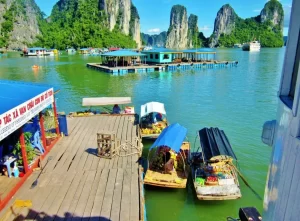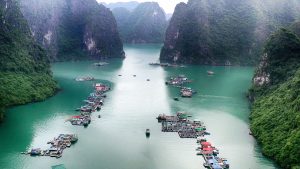Halong Bay, a UNESCO World Heritage Site, is famous for its emerald waters, towering limestone karsts, and stunning landscapes. However, beyond the breathtaking scenery, the bay is home to a unique and vibrant cultural heritage—its floating fishing villages. These villages offer a glimpse into a centuries-old way of life that has persisted despite modern developments.
The History of Floating Villages
The floating villages of Ha Long Bay date back hundreds of years. Originally established by fishing communities, these villages were built on wooden rafts and connected by floating walkways. Life on the water was dictated by the rhythms of the sea, with families relying on fishing and aquaculture for their livelihood. Today, while some villagers have moved to the mainland, a number still maintain their traditional way of life.
The Most Notable Floating Villages
- Cua Van Fishing Village: Perhaps the most well-known of Ha Long Bay’s floating villages, Cua Van is home to colorful floating houses and a small community that continues to practice traditional fishing methods. The village also has a cultural center where visitors can learn about its history and heritage.
- Vung Vieng Fishing Village: Located in Bai Tu Long Bay, Vung Vieng offers a more tranquil and less touristy experience. Visitors can take bamboo boat rides guided by local villagers, experiencing their daily routines and enjoying breathtaking views.
- Ba Hang Fishing Village: Close to Thien Cung Cave, Ba Hang is a smaller yet picturesque village where visitors can observe the simple lifestyle of the fishermen and even try their hand at rowing traditional bamboo boats.



Experiencing the Floating Villages
A visit to the floating villages provides travelers with a deeper understanding of the local culture. Activities include:
- Boat tours: Rowing through the calm waters of the village, guided by locals who share stories about their heritage.
- Fishing experiences: Learning traditional fishing techniques and even catching seafood the old-fashioned way.
- Seafood tasting: Enjoying fresh, locally caught seafood prepared in traditional Vietnamese styles.
- Exploring floating schools and markets: Observing how education and commerce thrive on the water.
Preserving a Unique Way of Life
The rise of tourism and environmental concerns have brought changes to the floating villages. Some communities have been relocated to land-based housing for better living conditions, while others continue to operate sustainably, preserving their traditions. Visitors can support these communities by choosing eco-friendly tour operators that respect the local environment and culture.
A trip to Ha Long Bay’s floating villages is more than just sightseeing—it’s an opportunity to immerse oneself in a unique and disappearing way of life. Whether paddling through the serene waters, engaging with friendly locals, or enjoying fresh seafood, travelers will leave with a deeper appreciation for the cultural richness of this UNESCO-listed paradise.

